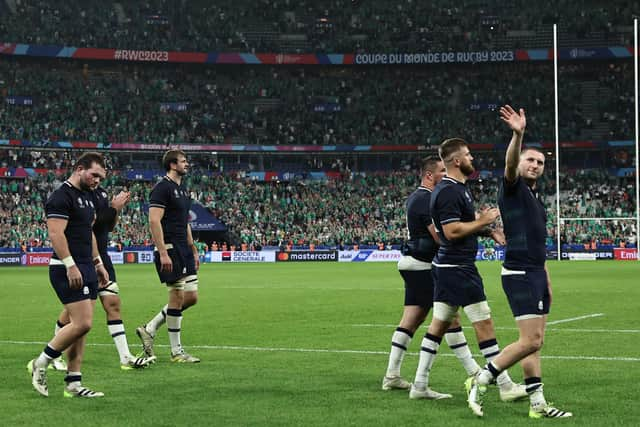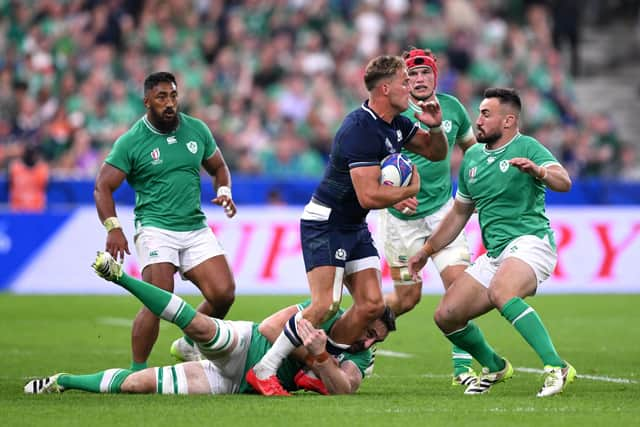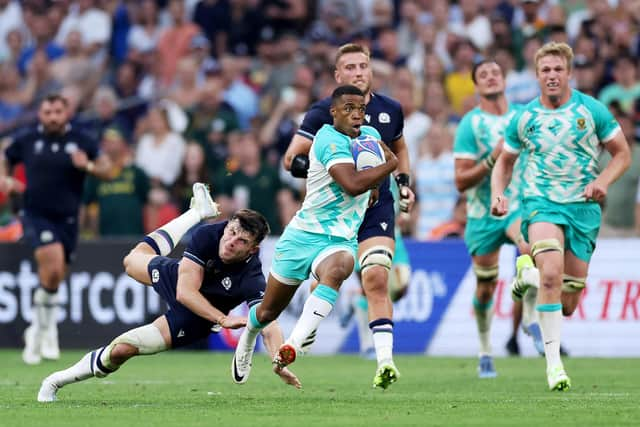Fraser Brown: Where Scotland went wrong in World Cup deciders, the issue beneath main squad and why there's no ceiling
Did they do this? I think they tried to but ultimately a lack of variety in their attack combined with slow ball at the breakdown – especially when carrying off nine – made it pretty easy for Ireland’s defence to snuff out Scotland’s attacking threats.
By 60 minutes Ireland had already scored six tries and taken off their most influential players before Scotland managed to trouble them. For the last few months, Scotland have looked to get the ball into the wide channels quickly to give their back three as much time as possible to attack the space and they have found plenty of success. We saw them beat France at home in the summer, then lose narrowly away in Saint-Etienne by doing just that. But in Saturday’s Pool B decider in Paris, it was a little too predictable and didn’t pose Ireland enough questions. The Irish defence was incredible, physical, quick to re-organise and a nightmare at the breakdown, but they never had different problems to solve – it was always the same picture to defend and ultimately it was never really put under too much pressure.
Advertisement
Hide AdAdvertisement
Hide AdIt was frustrating, particularly after the first 25-30 minutes when Scotland had struggled to break down Ireland’s defence. Even in the 10-15 minute period after Ireland’s first try when Scotland had possession and territory it never felt like they could create an opportunity to stress Ireland.


Scotland have struggled to break down both Ireland and South Africa’s defence at this World Cup but the two teams defend completely differently to each other. South Africa operate a blitz defence, built on extreme line-speed led from players wider in the defensive line. It was their line-speed in midfield, particularly through Pieter-Steph du Toit, who stopped Scotland getting to width by cutting out Finn Russell’s passing options.
Ireland are different, they bring line-speed from the first four or five defenders from the ruck to stop the momentum of the forward carriers and slow the breakdown and then go softer in the midfield. They are content to sit off a little bit and let Scotland play in front of them from deep and let them get to the wide channels. By not committing in midfield they then have the numbers to stop the threats out wide. Scotland talked all week about going to width so there was no element of surprise, and Ireland were happy to let them. Scotland ended up going deeper and deeper, playing behind forward carriers in midfield and never really committing any Irish defenders which made it all too easy for their defensive line to cover the threats out wide.
I think what was most disappointing was that when Scotland lost momentum in that middle part of the pitch, they didn’t look to kick the ball in behind, they didn’t look to transfer pressure. And when they were moving it to the wide channels, they didn’t look to thread balls through on the floor to turn the Irish defence.
I’m certain they will have talked about this during the week. Scotland have excellent kicking options across the entire back line; Ali Price, Russell, Sione Tuipulotu all have a superb touch with the boot. Scotland have one of the most dangerous counter attacks in the world, but it took them almost 60 minutes before they started looking for a kicking contest to create counter opportunities.


In the immediate aftermath of the World Cup exit there has been talk of a glass ceiling and that fifth in the world is as good as it'll get for Scotland. I don't agree. This is the best group of players Scotland have had for a while, perhaps ever, and it may be the best group we’ll have for the foreseeable future. I don’t think it’s a case of coming home, ripping it up and starting again. There will need to be an evolution of both squad and a way of playing but there is still scope for this group to grow and perform over the next year or two.
To say fifth in the world and third in the Six Nations is the best it’s going to get is too negative. Scotland didn’t play to their best against either South Africa or Ireland. And that’s a big hurdle – how do Scotland turn up and perform? How do they get the mental preparation right, how do they put in performance after performance against the top teams? For Scotland, the World Cup has been disappointing. There has been an evolution in their attack since the Six Nations but I don’t think it has been overly successful. Nevertheless, Scotland have the ability to beat any team. If you look at next year’s Six Nations, we have France at home who we’ve done well against at Murrayfield. You have to travel to Cardiff and to Dublin but I don’t think Wales will hold any fears for Scotland. England at home certainly holds no fear, and Italy – home or away – is a winnable game. Scotland obviously haven’t won in Dublin since 2010 so that is a huge test, potentially against the new world champions, but it’s a one-off game.
Looking deeper and in particular at the Scottish pathway system, you have to conclude that it isn’t producing. We don’t have as many talented young players coming through as other nations. There is untapped talent out there but the question is how we identify, develop and prepare it at an earlier stage than we do currently.
Advertisement
Hide AdAdvertisement
Hide AdIt’s also not a new problem. It’s not a case that we previously produced hundreds of great young players and now it’s suddenly stopped. Scotland have always had this ability to pull brilliant players out of seemingly nowhere.


It’s not like we have been churning out world class young players by the dozen over the last 10 or 15 years. But what cannot be denied is that other countries have vastly improved their academy system and their youth development and at a time where we seem to be stagnant, they are accelerating. Other countries get players between the ages of 18 and 20, just out of school or after a year in the academy, and they’re ready to play professional rugby. We get young men and women coming in at the same age and physically they’re not there yet and from a skill development point of view they’re nowhere near ready.
They’re spending two, three or four years in the academy and we have to spend so much time upskilling them to the point where we are comfortable putting them into professional games. Other nations are dropping these guys in at a far younger age. Look at France’s young winger Louis Bielle-Biarrey who played in the Under-20 Six Nations this year. He made his full Test debut against Scotland at Murrayfield in the summer and is now a key part of their squad. Size-wise, he’s not a colossus but he has unbelievable talent. His skill-set and his ability to read the game means France can drop him into the middle of a World Cup and you could argue he should be starting in the quarter-final against South Africa this weekend.
Wales are doing the same. For all their problems, if you look at some of the youth coming through you can see they are able to play them in pro games and even internationals. And Ireland seem able to put players into the Test environment almost a year after they come out of school.
We have smaller player numbers in Scotland but when they arrive in our professional set-ups they’re three or four years away from being able to compete at that level. Our focus needs to be on how we can develop these players at an earlier age by exposing them to top level coaching and more importantly, more higher quality competitive rugby. Unfortunately, by the time players reach the U-20s system or even the academies we are still having to spend time on coaching fundamental parts of the game; coaching young players how to lift and jump in the lineout for example. What we should be doing by that stage is giving them rugby knowledge about how to read lineout defences and how to call under pressure. In other words, see what’s in front of you and make good decisions.
Comments
Want to join the conversation? Please or to comment on this article.
